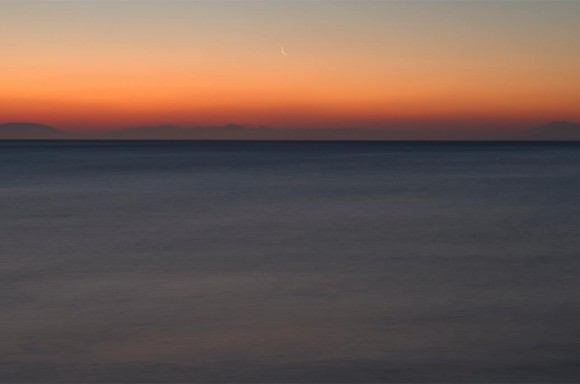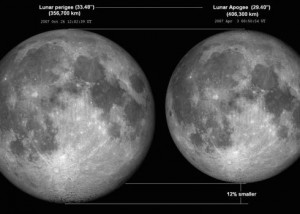In April 2015, the moon sweeps to perigee – the moon’s closest point to Earth for the month – on April 17 at 3:53 UTC. That is April 16 at 10:53 p.m. CDT, so it’s possible that – by the time you read this – April’s perigee will have passed. The moon at this perigee is 224,329 miles (361,023 km) from Earth. We list the dates for this year’s 13 lunar apogees (farthest points) and 13 lunar perigees (nearest points):
Shortest lunar month of 2015 starts on April 18
2015
| Apogee | Perigee | |
| January 9 | January 21 | |
| February 6 | February 19 | |
| March 5 | March 19 | |
| April 1 | April 17 | |
| April 29 | May 15 | |
| May 26 | June 10 | |
| June 23 | July 5 | |
| July 21 | August 2 | |
| August 18 | August 30 | |
| September 14 | September 28 | |
| October 11 | October 26 | |
| November 7 | November 23 | |
| December 5 | December 21 |
Enjoying EarthSky so far? Sign up for our free daily newsletter today!

View larger. | Today’s moon – April 17, 2015 – an “old” moon visible in the east shortly before dawn. EarthSky Facebook friend Nikolaos Pantazis captured it over the Corinthian Gulf in Greece. Thank you, Nikolaos!
Amazingly, in periods of four years, lunar apogees and perigees fall on the same, or nearly the same calendar dates. Let’s look four years ahead, to the year 2019:
2019
| Apogee | Perigee | |
| January 9 | January 21 | |
| February 5 | February 19 | |
| March 4 | March 19 | |
| April 1 | April 16 | |
| April 28 | May 13 | |
| May 26 | June 7 | |
| June 23 | July 5 | |
| July 20 | August 2 | |
| August 17 | August 30 | |
| September 13 | September 28 | |
| October 10 | October 26 | |
| November 7 | November 23 | |
| December 5 | December 18 |
Also, in cycles of two years, the calendar dates remain the same, or nearly so, except that the lunar apogees and perigees trade places. For instance, let’s look two years beyond 2015, to the year 2017:
2017
| Apogee | Perigee | |
| January 22 | January 10 | |
| February 18 | February 6 | |
| March 18 | March 3 | |
| April 15 | March 30 | |
| May 12 | April 27 | |
| June 8 | May 26 | |
| July 6 | June 23 | |
| August 2 | July 21 | |
| August 30 | August 18 | |
| September 27 | September 13 | |
| October 25 | October 9 | |
| November 21 | November 6 | |
| December 19 | December 4 |
Want to know more? Click here for a complete listing of all lunar perigees and apogees for the 21st century (2001 to 2100).
Intriguing cycle of farthest and closest moons
It is hard to believe that this rather straight-forward four-year apogee/perigee cycle is so little known among professional astronomers and lay people alike. Lunar apogees and lunar perigees align on the same, or nearly the same calendar dates every four years, because 53 returns to perigee is nearly commensurate with four calendar years. The mean length of the anomalistic month (perigee to perigee, or apogee to apogee) is 27.55455 days, whereas the average Gregorian year equals 365.2425 days. Hence:
27.55455 x 53 = 1460.3912 days
365.2425 x 4 = 1460.97 days

View larger. | Image via Wikipedia.

View larger. Image credit: NASA
Bottom line: in periods of four years, lunar apogees and perigees fall on the same, or nearly the same calendar dates.
